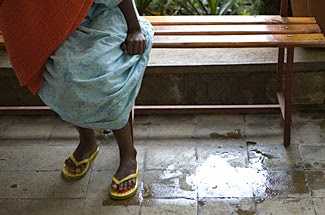
Shortly after Zimbabwe attained independence in 1980, the government constructed and upgraded maternity wings at all major hospitals, provided the necessary drugs and recruited well-trained midwives.
BY Moses Mugugunyeki
At one time, the government even abolished maternity fees at all health institutions, except central hospitals.
But over the past three decades the health standards in the country have fallen as experienced health personnel left the country and there has also been a marked reduction in fiscal allocation to the health sector.
The cheapest maternity health services in the country are offered by local authorities.
Maternal mortality continues to be a major challenge in Zimbabwe with most women dying due to pregnancy-related complications because of limited access to antenatal, delivery and post-natal care.
The major causes of maternal mortality are bacterial infection, uterine rupture (scar from a previous caesarean section tearing during an attempt at birth), obstructed labour, renal and cardiac failure as well as hyperemesis gravidarum (a condition characterised by severe nauasea, vomiting and weight loss during pregnancy).
Described as the “most devastating birth injury” by both the World Health Organisation (WHO) and the United Nations Population Fund (UNFPA), obstetric fistula is an abnormal communication between the urinary tract or the gastrointestinal tract and the genital tract, produced by obstetric causes, typically prolonged and obstructed labour.
- Chamisa under fire over US$120K donation
- Mavhunga puts DeMbare into Chibuku quarterfinals
- Pension funds bet on Cabora Bassa oilfields
- Councils defy govt fire tender directive
Keep Reading
Obstructed labour associated with obstetric fistula has been identified as a major cause of maternal mortality worldwide, and in as many as 90% of cases, women who experience obstetric fistula also suffer a stillbirth.
According to UNFPA, obstetric fistula affects between 50 000 and 100 000 women every year globally, with low income countries in Africa and Asia bearing the highest burden.
In Zimbabwe, the actual rate of obstetric fistula is not known, but given that the latest Multiple Indicator Cluster Survey from 2019 indicates that the country’s maternal mortality ratio is among the highest in the world, it can be expected there is a devastating prevalence and incidence rate of obstetric fistula in the country.
A recent Amnesty International report titled “I never thought I could get healed from this”: Barriers to treatment and human rights abuses against women and girls with obstetric fistula in Zimbabwe, exposed alarming gaps with regard to maternal healthcare in the country.
The research, which was carried out between January 2018 and October 2020, focuses on women and girls in Zimbabwe who have experienced obstetric fistula while giving birth, had its findings released concurrently with celebrations to mark World Obstetric Fistula Day last Sunday.
The commemorations were held under the theme Women’s rights are human rights! End fistula now!
The report said the government has done little to ameliorate the healthcare system, particularly maternal healthcare.
“Amidst an ever-worsening economic situation in Zimbabwe, as well as the country’s consistently low healthcare budget allocation, Amnesty International found that the government has failed to assign sufficient resources to the health sector, and despite declaring a policy of free maternal services, has not funded or operationalised relevant initiatives,” the report said.
“The lack of ambulances and high fuel prices further compounds delays that women and girls experience reaching and receiving care at health facilities. The situation is urgent as the country weathers the impact of the Covid-19 crisis and barriers to maternal health services are increasing.
“Amnesty International also found that various economic and cultural challenges undermined women’s agency to make decisions on where to give birth. A preference for home births was influenced by traditional practices and/or the costs associated with giving birth in health facilities, limiting women’s access to quality intra-partum care.
“However, in some cases, home births were found to expose pregnant women and girls to dangerous health complications and violence.”
The report documented serious abuse that may amount to torture and ill-treatment of women and girls committed by private individuals, during labour at home.
“Women and girls were left with life-changing injuries and often hospitalised for weeks or months and faced astronomical bills as a result. The government of Zimbabwe has an obligation to investigate these cases.”
The report further indicates that lack of information about the causes and treatment of obstetric fistula increased women’s risk of discrimination and abuse within their families and communities.
Most women live for years with obstetric fistula, or undiagnosed conditions of incontinence related to childbirth, with many thinking they were the only person with the condition.
“It’s been three years now, I can’t wear underwear, urine is always leaking. I have developed sores on my genitals that aren’t healing because of the moisture. I dread going out in public,” said Nyaradzai, a 19-year-old woman from Mashonaland West province, one of the participant of the study.
“The last time I went to a gathering, people distanced themselves from me because of the bad smell, it repelled them. I’m confined to this house so I can bathe each time I soil myself. My entire family believes I was cursed, they say no one has ever had a disease like mine before.”
Around the 1980s when all was rosy in the health sector, the country had a low maternal mortality rate of just 90 per 100 000 live births.
However, in 1994 the gains in the health sector plummeted to 253 per 100 000 live births. As if this was not enough, a more frightening situation was still to come.
According to the 2012 National Census Report, the maternal mortality ratio in 2012 was 525 per 100 000 live births. Health experts say Zimbabwe is losing eight women a day due to death caused by pregnancy complications.
However, if drastic action is not taken to revive the collapsing health sector; the government cannot attain Sustainable Development Goal (SDG) of reducing the global maternal mortality ratio to less than 70 per 100,000 live births by 2030.
“Achieving the 2030 SDG target requires government to prioritise the healthcare system and continue investment in maternal health research, programmes and policy,” said public health expert Johannes Marisa.
According to the World Health Organisation (WHO), obstetric fistula can be prevented by reducing the number of early and unplanned pregnancies, by ending harmful practices, such as child marriage, and ensuring access to quality emergency obstetric care, especially caesarean section.
Globally, obstetric fistula has been almost entirely eradicated in high income countries where there is access to quality obstetric care, yet more than two million women in low income countries, like Zimbabwe, are living with obstetric fistula, and UNFPA estimate “50,000 to 100,000 new cases develop each year.”










